Aligning Pixel Values of DMSP and VIIRS Nighttime Light Images to Evaluate Urban Dynamics
Abstract
:1. Introduction
2. Study Area and Data
3. Methodology
3.1. Calibrating DMSP Annual Composites
3.2. Producing VIIRS Annual Composites
3.3. Simulating DMSP with VIIRS Annual Composites
3.4. Evaluation of Consistency in Pixel Values and Correlation Between NTL and GDP
4. Results
4.1. Intercalibration of DMSP Annual Composites
4.2. VIIRS and Simulated DMSP Annual Composites
4.3. Correlation Between NTL and GDP
5. Discussion
6. Conclusions
Supplementary Materials
Author Contributions
Funding
Acknowledgments
Conflicts of Interest
References
- Guan, W.W.; Wu, K.; Carnes, F. Modeling spatiotemporal pattern of agriculture-feasible land in china. Trans. GIS 2016, 20, 426–447. [Google Scholar] [CrossRef]
- Riahi, K.; Van Vuuren, D.P.; Kriegler, E.; Edmonds, J.; O’neill, B.C.; Fujimori, S.; Bauer, N.; Calvin, K.; Dellink, R.; Fricko, O.; et al. The shared socioeconomic pathways and their energy, land use, and greenhouse gas emissions implications: An overview. Glob. Environ. Chang. 2017, 42, 153–168. [Google Scholar] [CrossRef]
- Jiang, L.; O’Neill, B.C. Global urbanization projections for the shared socioeconomic pathways. Glob. Environ. Chang. 2017, 42, 193–199. [Google Scholar]
- Samir, K.; Lutz, W. The human core of the shared socioeconomic pathways: Population scenarios by age, sex and level of education for all countries to 2100. Glob. Environ. Chang. 2017, 42, 181–192. [Google Scholar]
- Leimbach, M.; Kriegler, E.; Roming, N.; Schwanitz, J. Future growth patterns of world regions–a gdp scenario approach. Glob. Environ. Chang. 2017, 42, 215–225. [Google Scholar] [CrossRef]
- Bauer, N.; Calvin, K.; Emmerling, J.; Fricko, O.; Fujimori, S.; Hilaire, J.; Eom, J.; Krey, V.; Kriegler, E.; Mouratiadou, I.; et al. Shared socio-economic pathways of the energy sector–quantifying the narratives. Glob. Environ. Chang. 2017, 42, 316–330. [Google Scholar] [CrossRef]
- Park, J. Projection of Long-Term Total Factor Productivity Growth for 12 Asian Economies; Asian Development Bank ADB Economics Working Paper Series; The Asian Development Bank (ADB): Metro Manila, Philippines, 2010. [Google Scholar]
- Bennett, M.M.; Smith, L.C. Advances in using multitemporal night-time lights satellite imagery to detect, estimate, and monitor socioeconomic dynamics. Remote Sens. Environ. 2017, 192, 176–197. [Google Scholar] [CrossRef]
- Xu, M.; He, C.; Liu, Z.; Dou, Y. How did urban land expand in china between 1992 and 2015? A multi-scale landscape analysis. PLoS ONE 2016, 11, e0154839. [Google Scholar] [CrossRef]
- Wei, Y.; Liu, H.; Song, W.; Yu, B.; Xiu, C. Normalization of time series dmsp-ols nighttime light images for urban growth analysis with pseudo invariant features. Landsc. Urban Plan. 2014, 128, 1–13. [Google Scholar] [CrossRef]
- He, C.; Liu, Z.; Tian, J.; Ma, Q. Urban expansion dynamics and natural habitat loss in china: A multiscale landscape perspective. Glob. Chang. Biol. 2014, 20, 2886–2902. [Google Scholar] [CrossRef]
- Ma, T.; Zhou, Y.; Zhou, C.; Haynie, S.; Pei, T.; Xu, T. Night-time light derived estimation of spatio-temporal characteristics of urbanization dynamics using dmsp/ols satellite data. Remote Sens. Environ. 2015, 158, 453–464. [Google Scholar] [CrossRef]
- Yu, S.; Zhang, Z.; Liu, F. Monitoring population evolution in china using time-series dmsp/ols nightlight imagery. Remote Sens. 2018, 10, 194. [Google Scholar] [CrossRef]
- Ma, T.; Zhou, C.; Pei, T.; Haynie, S.; Fan, J. Quantitative estimation of urbanization dynamics using time series of dmsp/ols nighttime light data: A comparative case study from china’s cities. Remote Sens. Environ. 2012, 124, 99–107. [Google Scholar]
- Román, M.O.; Stokes, E.C. Holidays in lights: Tracking cultural patterns in demand for energy services. Earth’s Future 2015, 3, 182–205. [Google Scholar] [PubMed]
- Shi, K.; Chen, Y.; Yu, B.; Xu, T.; Chen, Z.; Liu, R.; Li, L.; Wu, J. Modeling spatiotemporal co2 (carbon dioxide) emission dynamics in china from dmsp-ols nighttime stable light data using panel data analysis. Appl. Energy 2016, 168, 523–533. [Google Scholar] [CrossRef]
- Yu, B.; Shi, K.; Hu, Y.; Huang, C.; Chen, Z.; Wu, J. Poverty evaluation using npp-viirs nighttime light composite data at the county level in china. IEEE J. Sel. Top. Appl. Earth Obs. Remote Sens. 2015, 8, 1217–1229. [Google Scholar]
- Noaa’s National Centers for Environmental Information. Available online: https://www.ngdc.noaa.gov/ (accessed on 20 September 2018).
- Shao, X.; Cao, C.; Zhang, B.; Qiu, S.; Elvidge, C.; Von Hendy, M. Radiometric calibration of dmsp-ols sensor using viirs day/night band. In Earth Observing Missions and Sensors: Development, Implementation, and Characterization III; International Society for Optics and Photonics: Beijing, China, 2014; p. 92640A. [Google Scholar]
- Li, X.; Li, D.; Xu, H.; Wu, C. Intercalibration between dmsp/ols and viirs night-time light images to evaluate city light dynamics of syria’s major human settlement during syrian civil war. Int. J. Remote Sens. 2017, 38, 5934–5951. [Google Scholar] [CrossRef]
- Zheng, Q.; Weng, Q.; Wang, K. Developing a new cross-sensor calibration model for dmsp-ols and suomi-npp viirs night-light imageries. ISPRS J. Photogramm. Remote Sens. 2019, 153, 36–47. [Google Scholar] [CrossRef]
- Beijing Macroeconomic and Social Development Database. Available online: http://43.254.24.2/ww/MenuItemAction!queryMenu (accessed on 5 December 2018).
- People’s Government of Yiwu. Available online: http://www.yw.gov.cn/11330782002609848G/a/07/03_1/2018/gb/index.html (accessed on 15 March 2019).
- Elvidge, C.; Ziskin, D.; Baugh, K.; Tuttle, B.; Ghosh, T.; Pack, D.; Erwin, E.; Zhizhin, M. A fifteen year record of global natural gas flaring derived from satellite data. Energies 2009, 2, 595–622. [Google Scholar] [CrossRef]
- Li, X.; Chen, X.; Zhao, Y.; Xu, J.; Chen, F.; Li, H. Automatic intercalibration of night-time light imagery using robust regression. Remote Sens. Lett. 2013, 4, 45–54. [Google Scholar] [CrossRef]
- Ma, W.; Li, P. An object similarity-based thresholding method for urban area mapping from visible infrared imaging radiometer suite day/night band (viirs dnb) data. Remote Sens. 2018, 10, 263. [Google Scholar] [CrossRef]
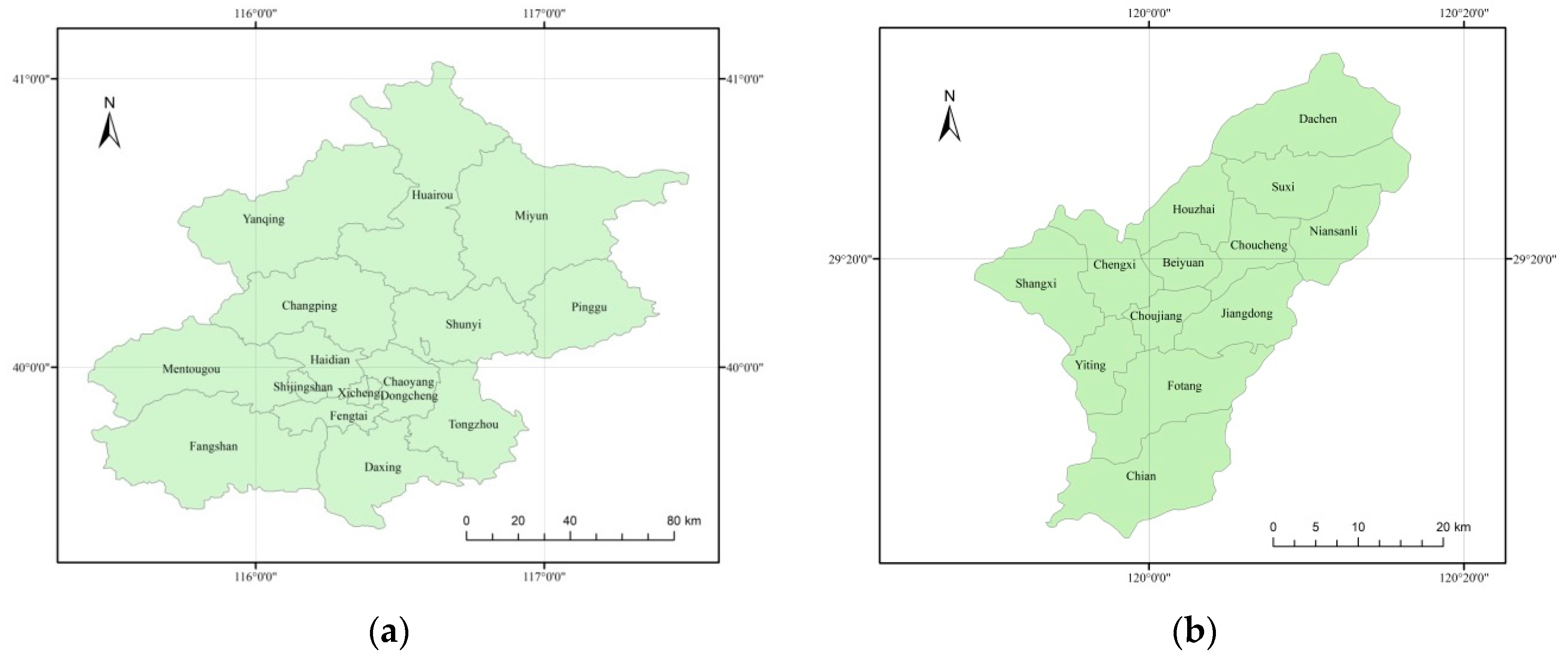
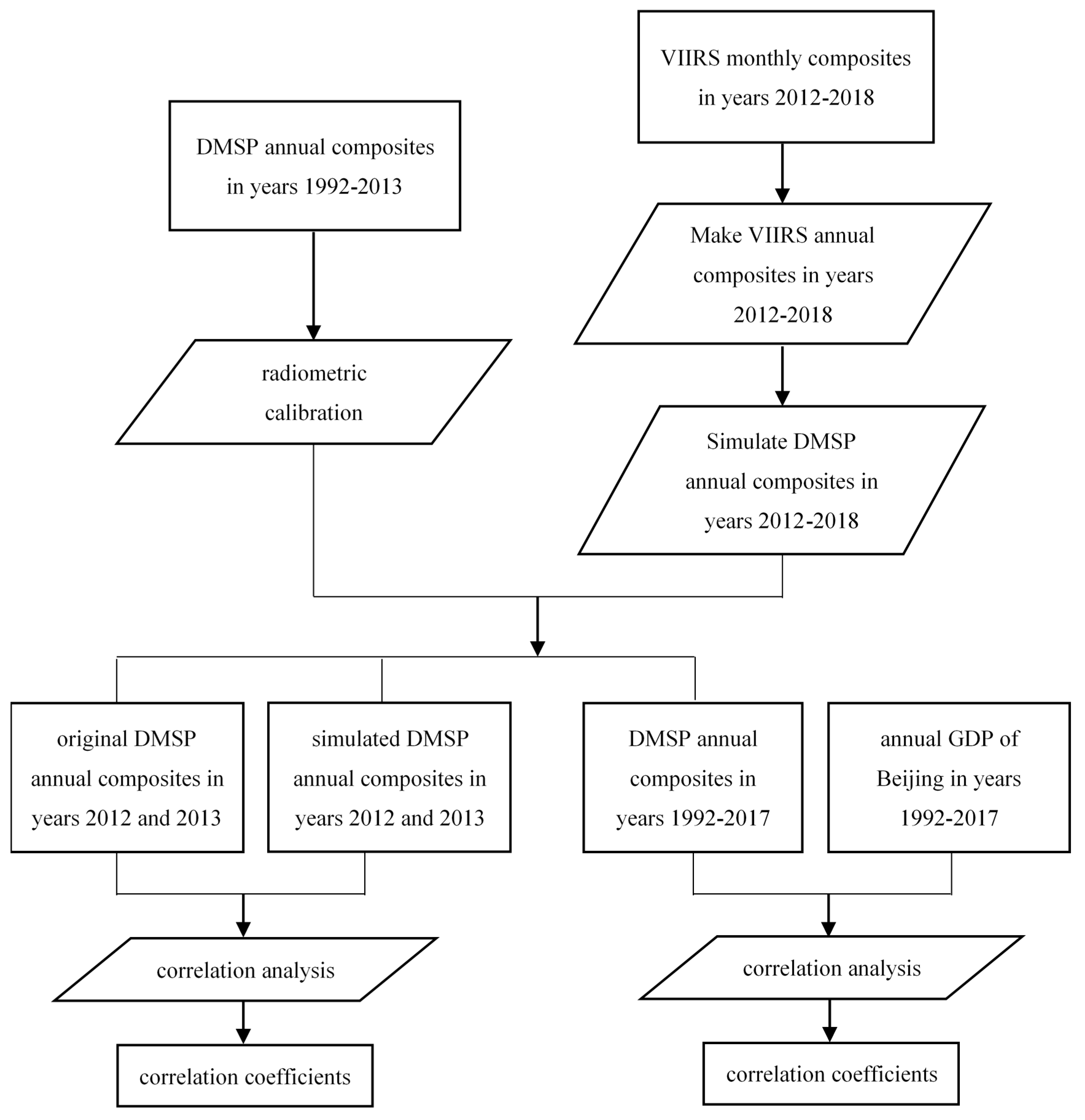
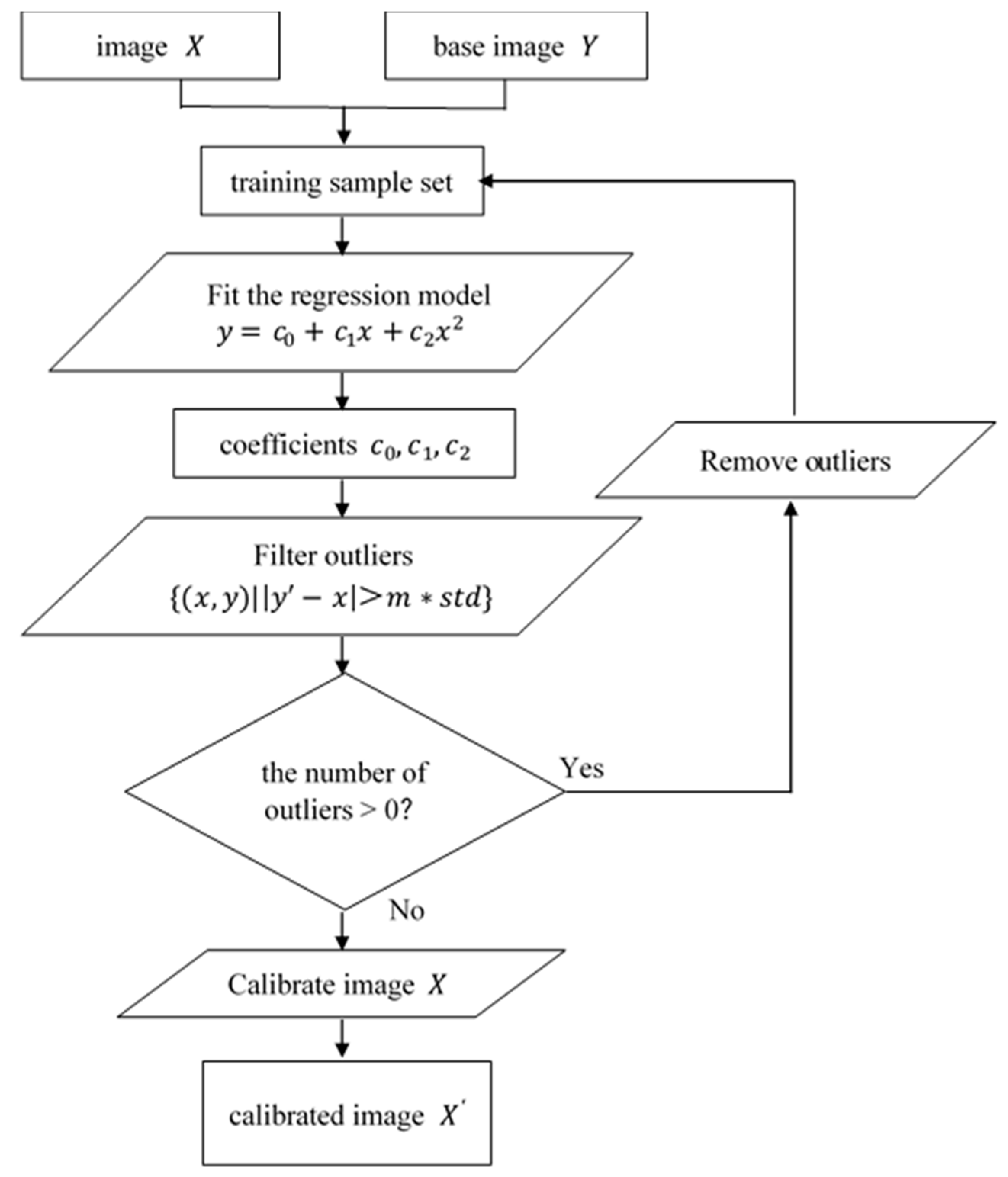
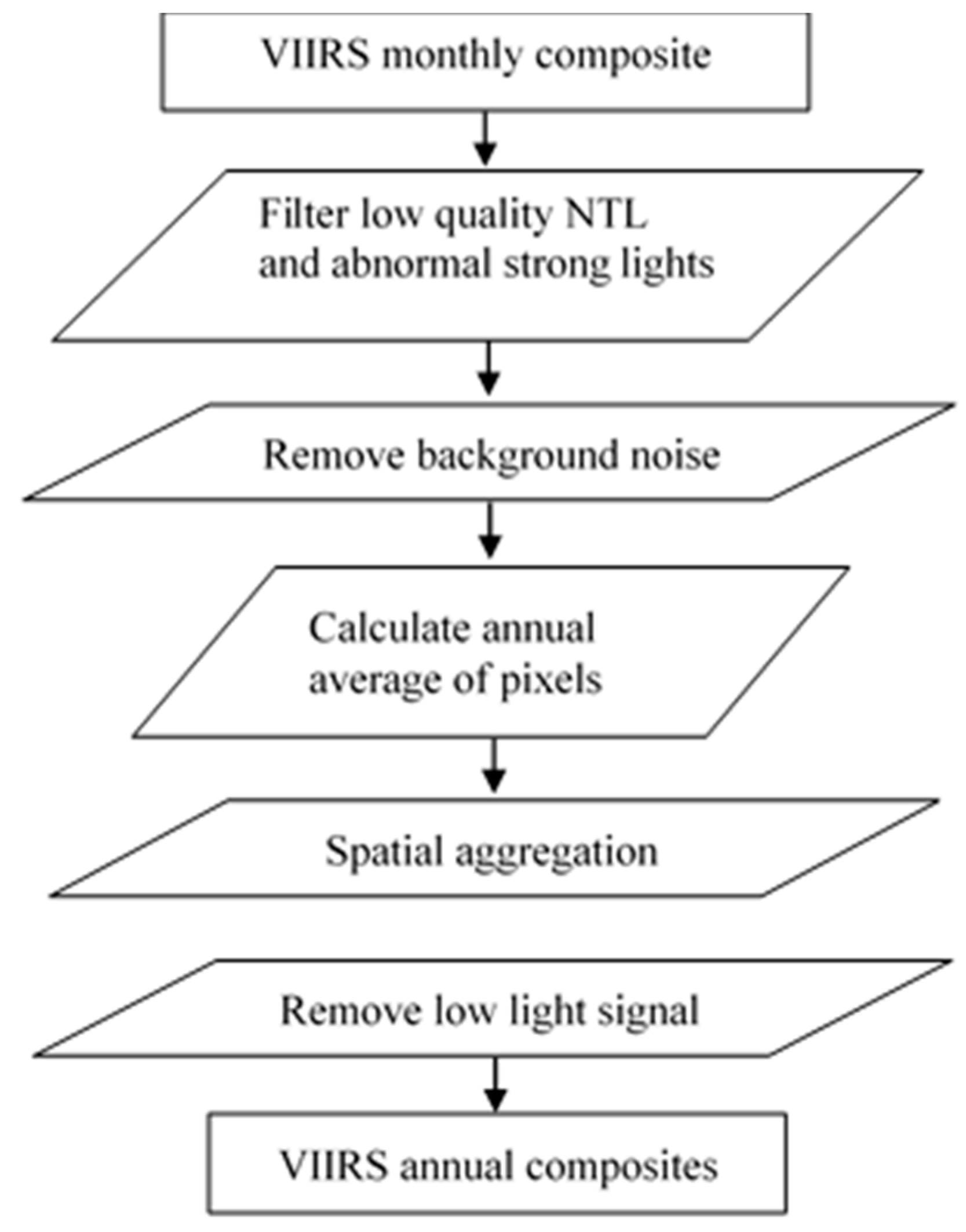
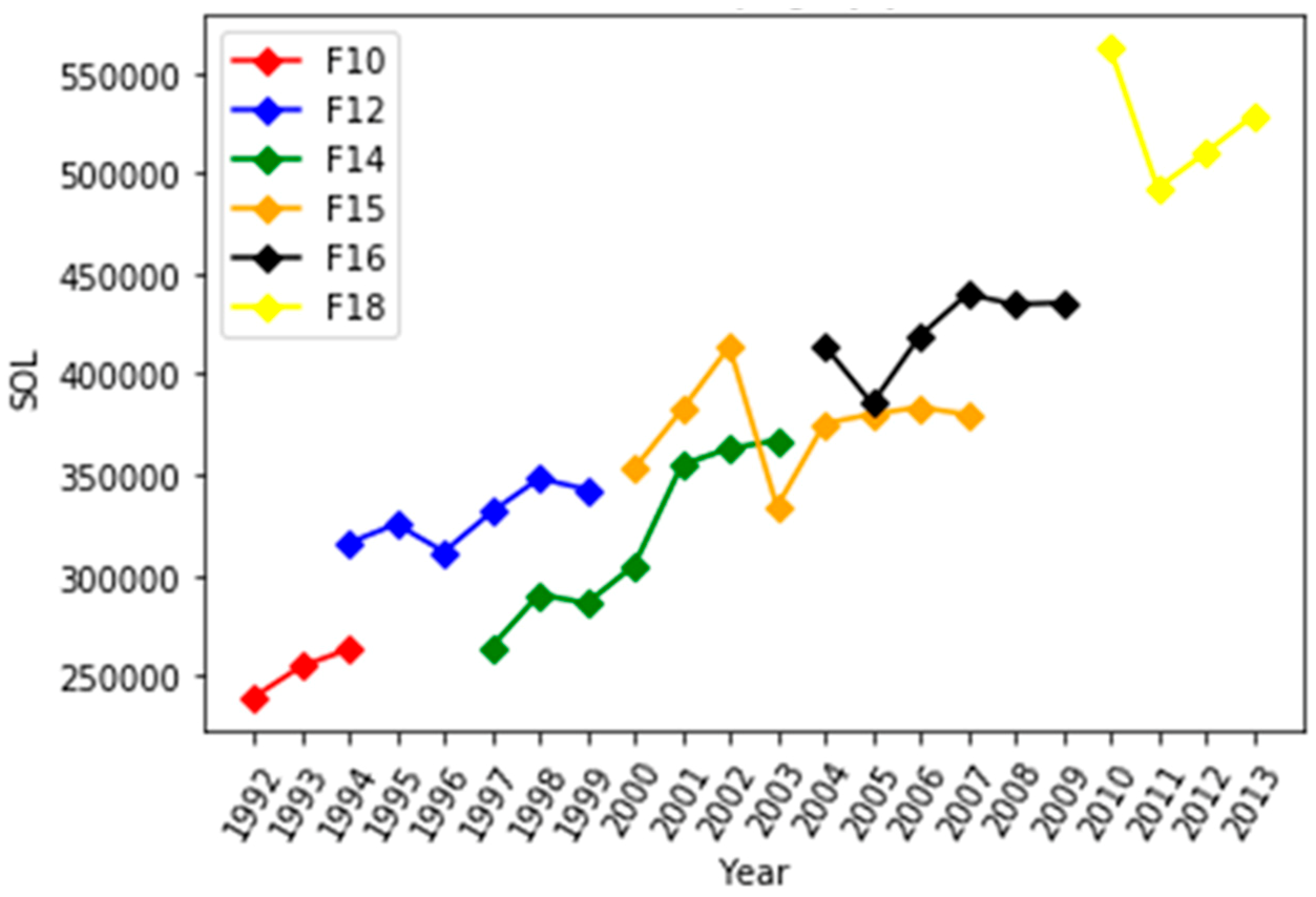
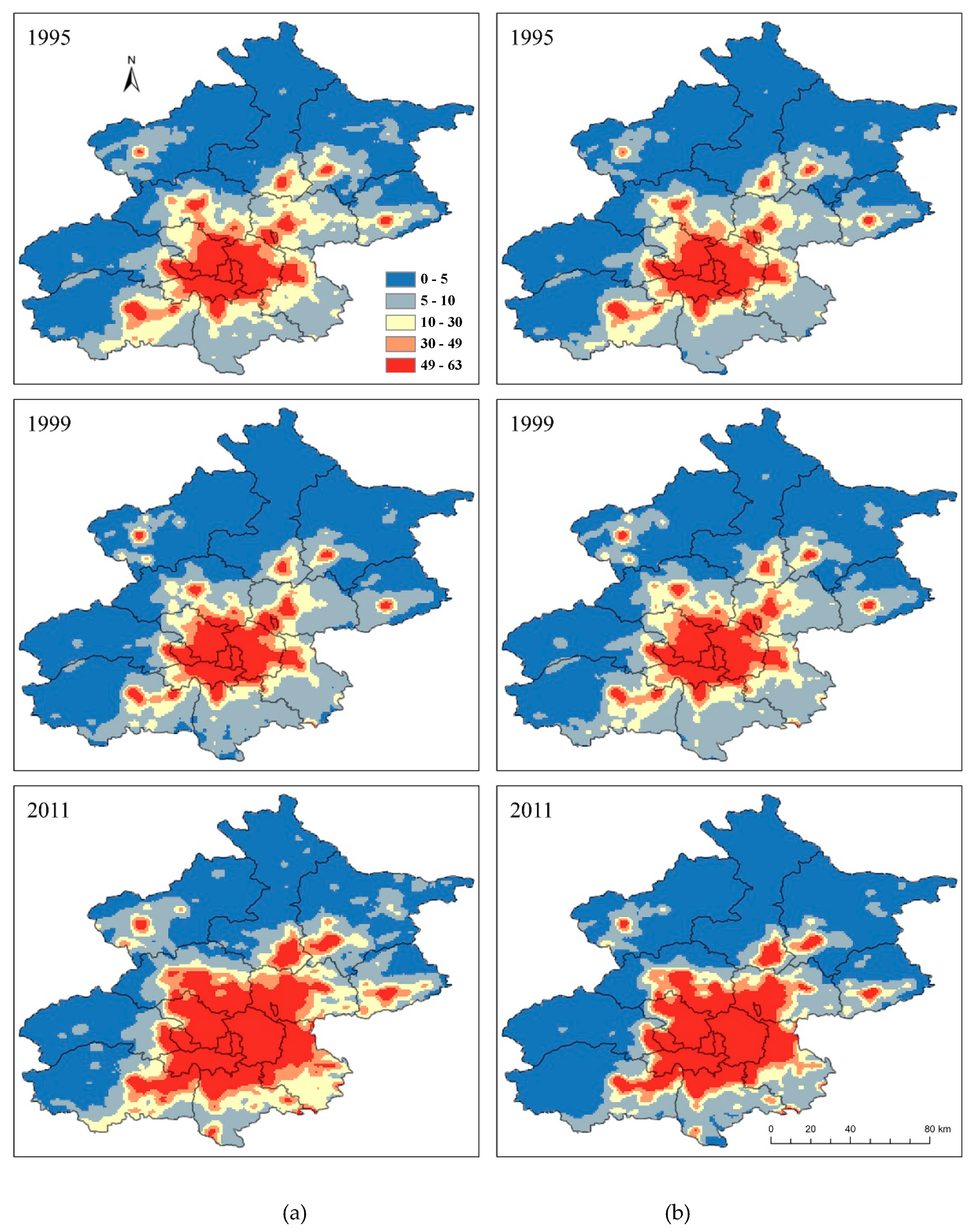
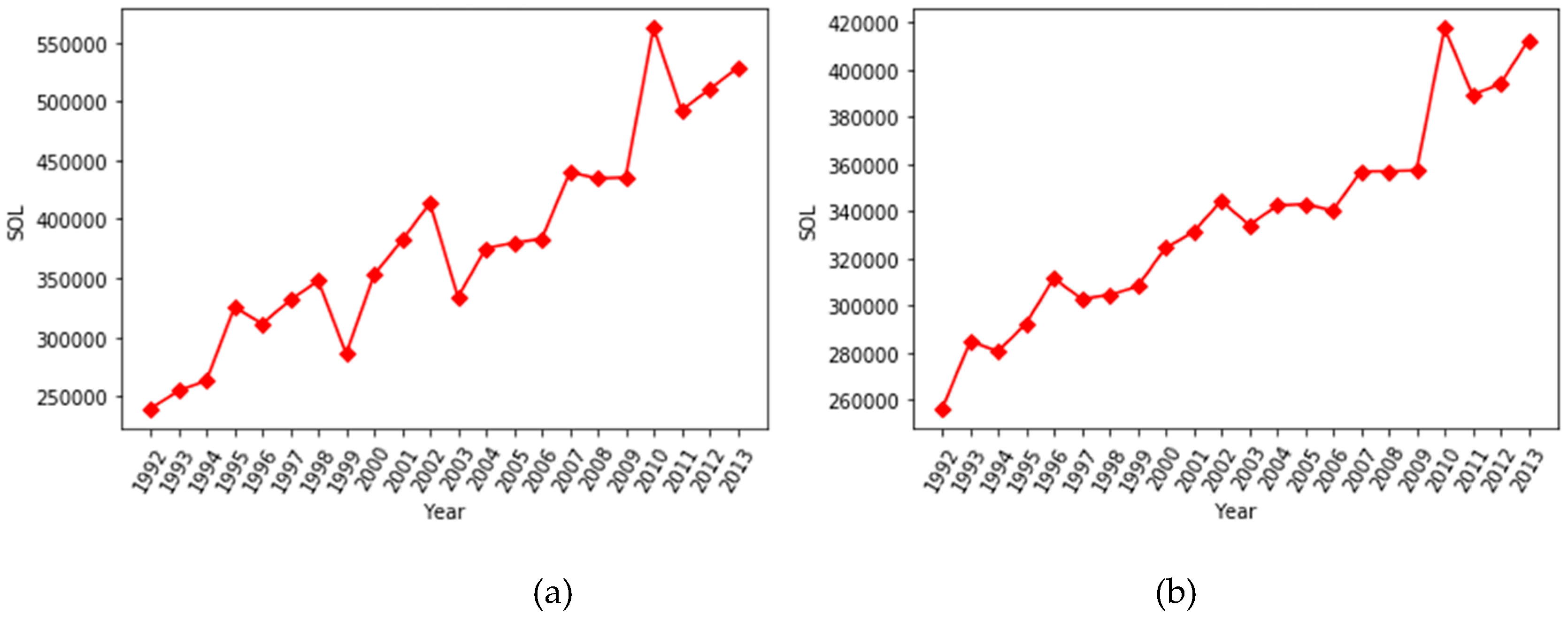
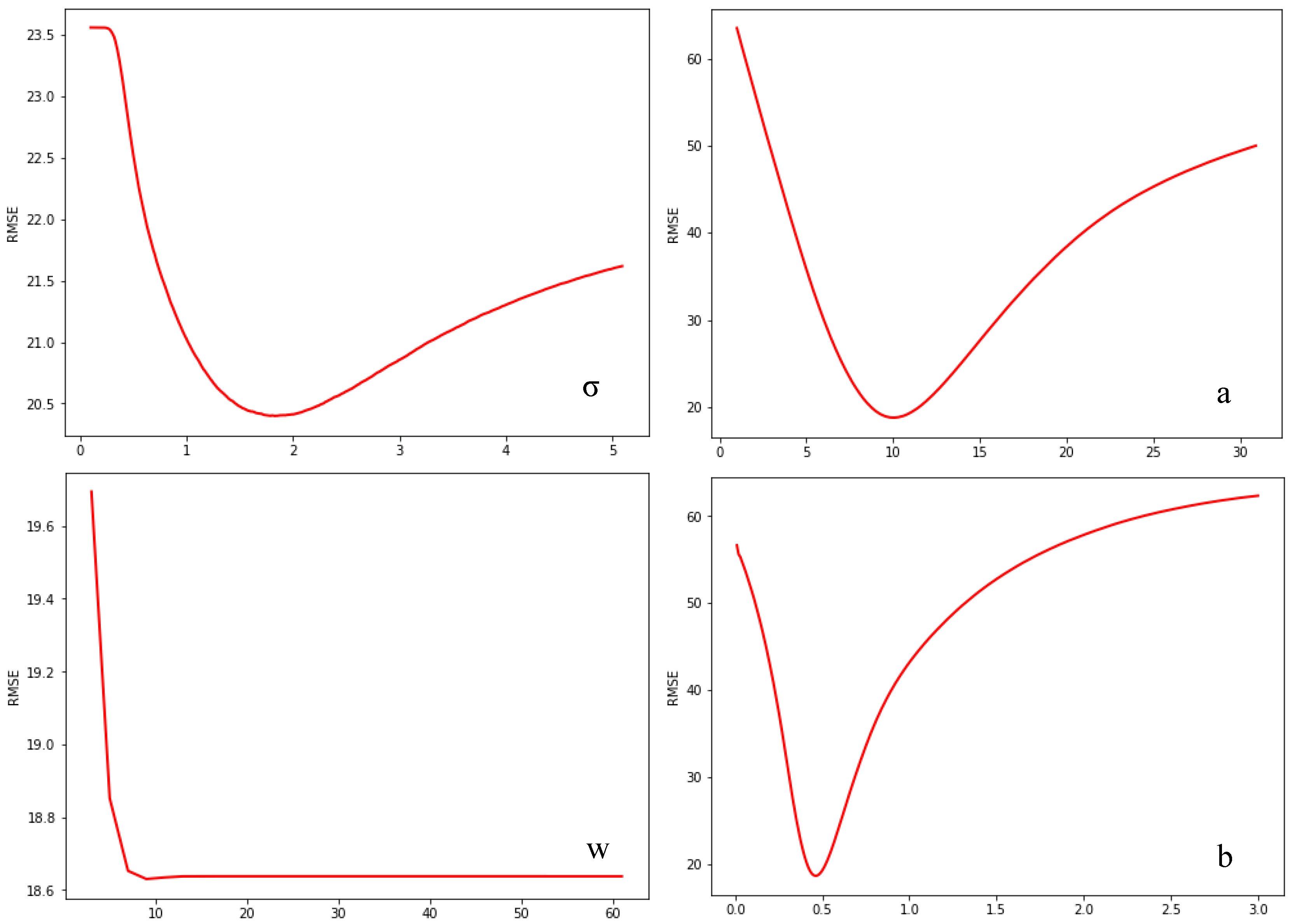
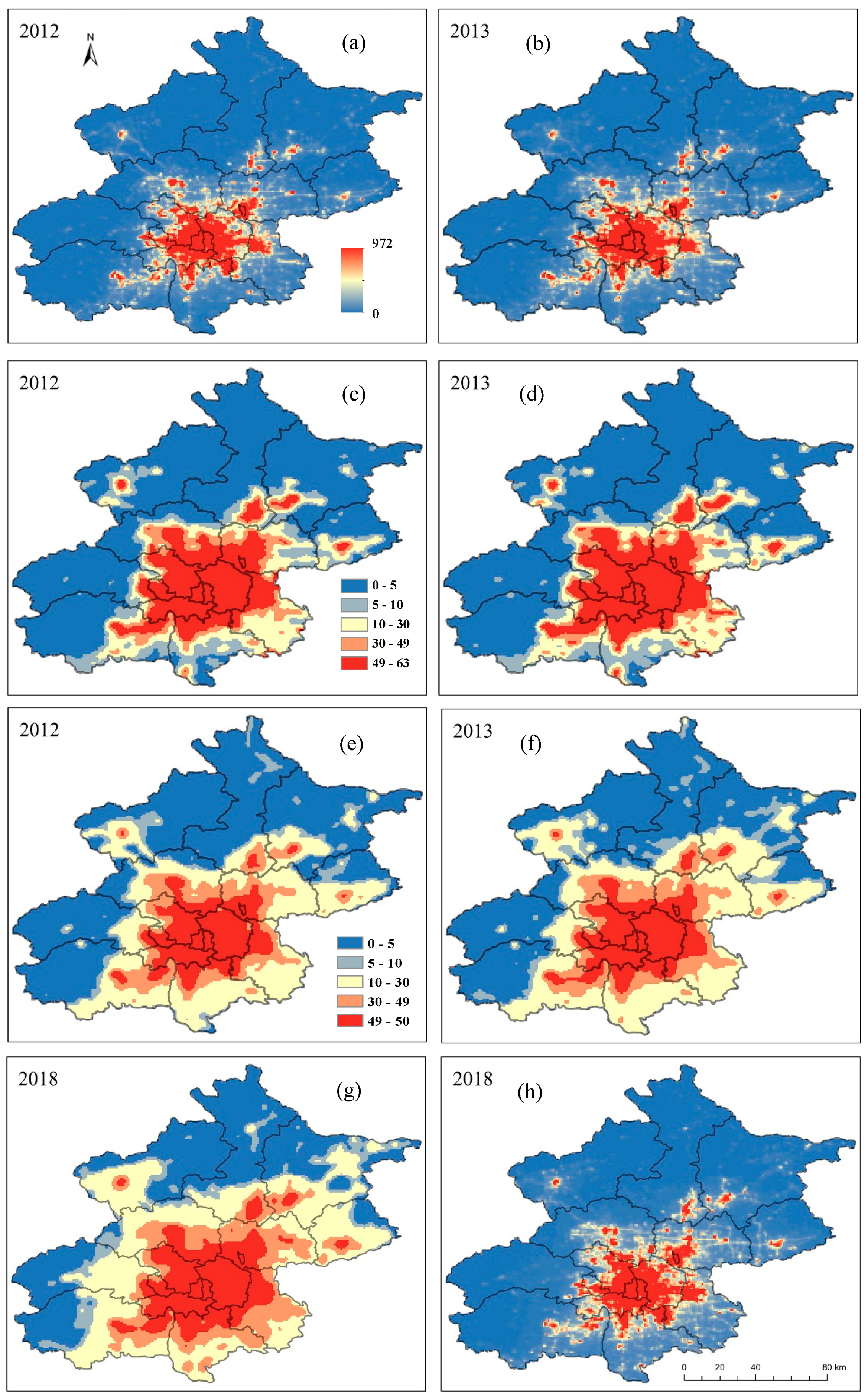
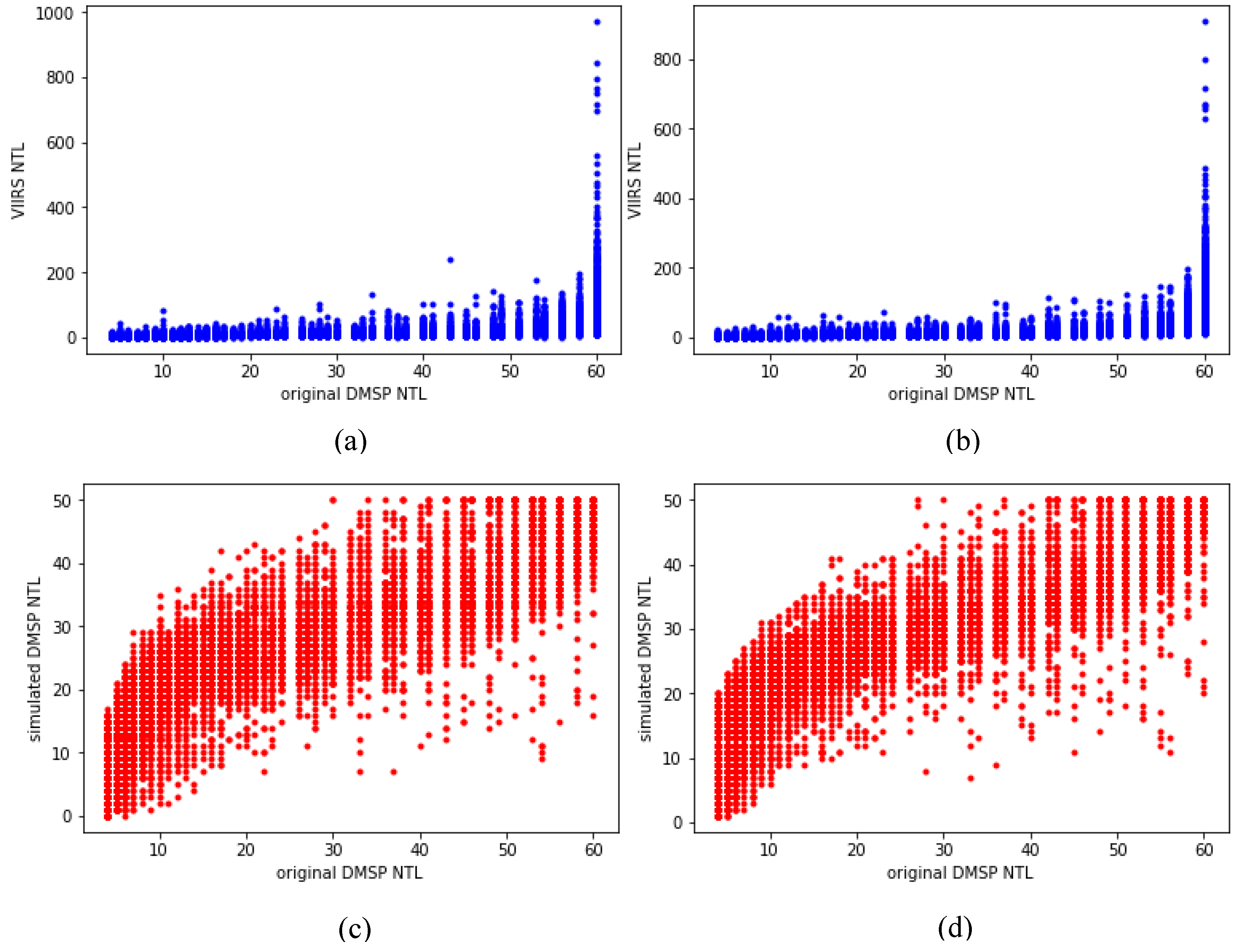
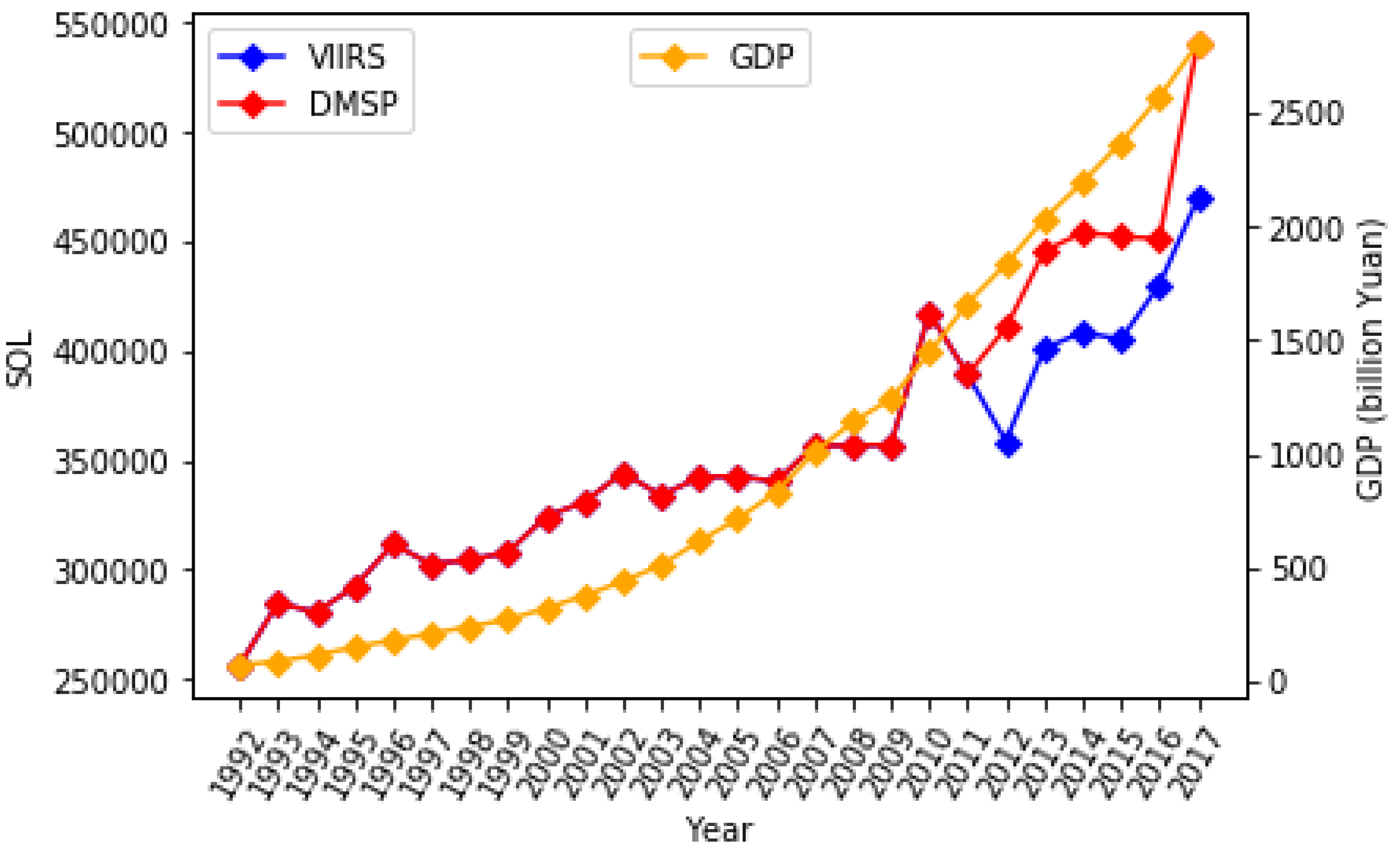
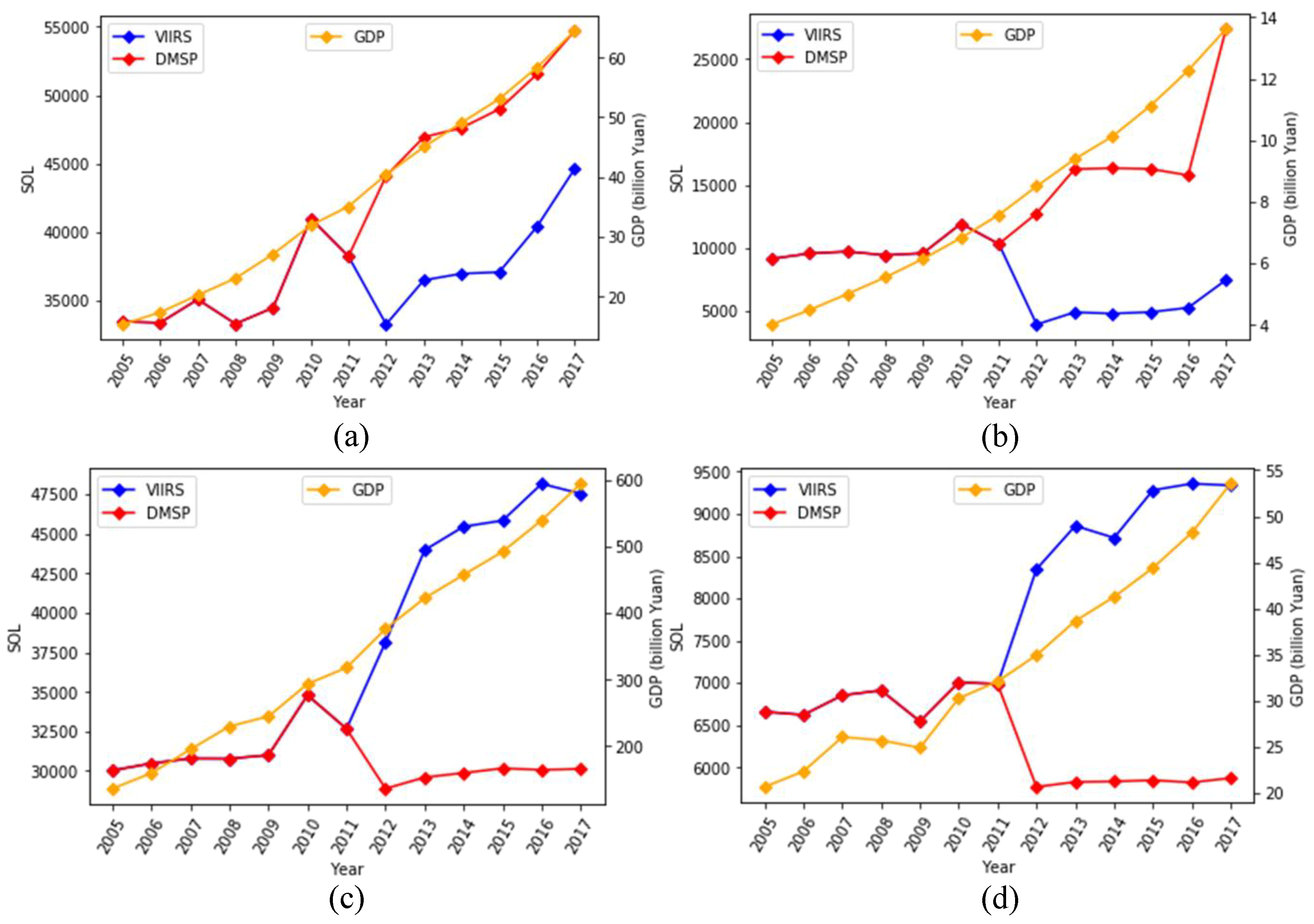
| NTL Source | DMSP/OLS | Suomi NPP/VIIRS |
|---|---|---|
| Spatial resolution | 2.7 km | 742 m |
| Radiometric resolution | 6-bit | 12-or 14-bit |
| Wavelength range | 0.4–1.1 μm | 505–890 μm |
| On-board calibration | No | Yes |
| Units of pixel values | Relative (0–63 scale) | Radiance () |
| Light range detected () | (specified, actual detected noise floor is ) | |
| Night overpass time | 20:30–21:30 | 1:30 |
| Available temporal sequence | 1992–2013 annual composites (free) 1992–2014 monthly composites (charged) | 2012–present monthly composites (free) 2015–2016 annual composites (free) |
| Year | Sensor of NTL | Score | |||
|---|---|---|---|---|---|
| 1992 | F10 | 2.097 | 0.925 | 0.001 | 0.970 |
| 1993 | F10 | −0.805 | 1.319 | −0.005 | 0.975 |
| 1994 | F10 | 0.286 | 1.105 | −0.002 | 0.983 |
| 1995 | F12 | 0.893 | 0.698 | 0.004 | 0.991 |
| 1996 | F12 | −0.391 | 1.024 | 0 | 0.986 |
| 1997 | F12 | 0.133 | 0.809 | 0.003 | 0.992 |
| 1998 | F12 | 0.682 | 0.666 | 0.005 | 0.992 |
| 1999 | F14 | 0.144 | 1.182 | −0.003 | 0.990 |
| 2000 | F15 | −0.131 | 0.804 | 0.003 | 0.992 |
| 2001 | F15 | −0.123 | 0.702 | 0.004 | 0.996 |
| 2002 | F15 | 0.860 | 0.500 | 0.007 | 0.997 |
| 2003 | F15 | - | - | - | - |
| 2004 | F15 | 1.165 | 0.690 | 0.004 | 0.997 |
| 2005 | F15 | 1.360 | 0.660 | 0.004 | 0.996 |
| 2006 | F15 | 2.054 | 0.511 | 0.007 | 0.996 |
| 2007 | F16 | 2.408 | 0.248 | 0.011 | 0.996 |
| 2008 | F16 | 2.515 | 0.293 | 0.010 | 0.993 |
| 2009 | F16 | 2.869 | 0.238 | 0.011 | 0.994 |
| 2010 | F18 | 4.250 | −0.185 | 0.017 | 0.995 |
| 2011 | F18 | 3.509 | 0.035 | 0.014 | 0.994 |
| 2012 | F18 | 3.721 | −0.053 | 0.015 | 0.995 |
| 2013 | F18 | 3.641 | −0.051 | 0.015 | 0.996 |
| Original DMSP NTL | |||
|---|---|---|---|
| Year 2012 | Year 2013 | ||
| VIIRS NTL | Year 2012 | 0.637/34.804 | - |
| Year 2013 | - | 0.658/35.526 | |
| Simulated DMSP NTL | Year 2012 | 0.937/9.244 | - |
| Year 2013 | - | 0.945/9.387 | |
| District | Without Simulation | With Simulation |
|---|---|---|
| Changping | −0.451 | 0.892 |
| Chaoyang | 0.916 | −0.840 |
| Daxing | 0.727 | 0.980 |
| Dongcheng | 0.876 | −0.876 |
| Fangshan | −0.349 | 0.937 |
| Fengtai | 0.951 | −0.635 |
| Haidian | 0.963 | −0.263 |
| Huairou | −0.384 | 0.897 |
| Mentougou | −0.519 | 0.822 |
| Miyun | −0.616 | 0.896 |
| Pinggu | −0.710 | 0.888 |
| Shijingshan | 0.948 | −0.768 |
| Shunyi | 0.675 | 0.968 |
| Tongzhou | 0.676 | 0.976 |
| Xicheng | 0.881 | −0.887 |
| Yanqing | −0.655 | 0.890 |
© 2019 by the authors. Licensee MDPI, Basel, Switzerland. This article is an open access article distributed under the terms and conditions of the Creative Commons Attribution (CC BY) license (http://creativecommons.org/licenses/by/4.0/).
Share and Cite
Wu, K.; Wang, X. Aligning Pixel Values of DMSP and VIIRS Nighttime Light Images to Evaluate Urban Dynamics. Remote Sens. 2019, 11, 1463. https://doi.org/10.3390/rs11121463
Wu K, Wang X. Aligning Pixel Values of DMSP and VIIRS Nighttime Light Images to Evaluate Urban Dynamics. Remote Sensing. 2019; 11(12):1463. https://doi.org/10.3390/rs11121463
Chicago/Turabian StyleWu, Kang, and Xiaonan Wang. 2019. "Aligning Pixel Values of DMSP and VIIRS Nighttime Light Images to Evaluate Urban Dynamics" Remote Sensing 11, no. 12: 1463. https://doi.org/10.3390/rs11121463
APA StyleWu, K., & Wang, X. (2019). Aligning Pixel Values of DMSP and VIIRS Nighttime Light Images to Evaluate Urban Dynamics. Remote Sensing, 11(12), 1463. https://doi.org/10.3390/rs11121463






